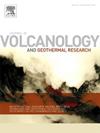Experimental constraints on the behaviour of sulphur in the 2021 Cumbre Vieja (La Palma) basanite
IF 2.4
3区 地球科学
Q2 GEOSCIENCES, MULTIDISCIPLINARY
Journal of Volcanology and Geothermal Research
Pub Date : 2024-11-02
DOI:10.1016/j.jvolgeores.2024.108219
引用次数: 0
Abstract
We performed experiments to constrain the effects of sulphur and oxygen fugacities on magma chamber and outgassing conditions of the La Palma 2021 eruption. Based on a series of controlled experiments on basanitic products carried out at 1040 °C and 200 MPa, we show that sulphur addition affects the stabilities of amphibole and olivine, in particular at high fO2 and elevated S contents which together inhibit amphibole crystallization. We also show that the overriding control on S systematics is oxygen fugacity, with melts capable of dissolving from 1000 up to 8000 ppm S, depending on fO2. Increasing the bulk S content increases the S content of the silicate melt up to ∼2000 ppm for fO2 < NNO + 2, and 7000–8000 ppm at higher fO2. Further increase in dissolved S is prevented by the buffering effects of either sulphide at low fO2 or anhydrite at high fO2. Modelling shows that the observed CO2/SO2 and H2O/SO2 ratios of volcanic gas emissions during the eruption imply a pre-existing >5 wt% exsolved fluid in the reservoir, with fS2 at ∼0.1 MPa at fO2 above NNO. Our work confirms that basaltic magmas may coexist with a significant amount of excess fluid which in turn holds an important part of the sulphur budget emitted to the atmosphere.
关于 2021 年坎布雷维埃哈(拉帕尔马)玄武岩中硫的行为的实验制约因素
我们进行了实验,以确定硫和氧的富集度对拉帕尔马 2021 火山喷发的岩浆室和排气条件的影响。基于在 1040 °C 和 200 MPa 条件下对玄武岩产物进行的一系列受控实验,我们发现硫的添加会影响闪石和橄榄石的稳定性,尤其是在高 fO2 和 S 含量升高的情况下,硫的添加会共同抑制闪石的结晶。我们还表明,对硫系统学的最主要控制因素是逸氧性,根据 fO2 的不同,熔体能够溶解 1000 至 8000 ppm 的硫。在 fO2 < NNO + 2 条件下,增加体积 S 含量可使硅酸盐熔体中的 S 含量达到 ∼ 2000 ppm,而在更高的 fO2 条件下,则可达到 7000-8000 ppm。在低 fO2 条件下,硫化物的缓冲作用阻止了溶解 S 的进一步增加;在高 fO2 条件下,无水石膏的缓冲作用阻止了溶解 S 的进一步增加。建模表明,在喷发过程中观测到的火山气体排放的 CO2/SO2 和 H2O/SO2 比率意味着储层中预先存在 5 wt%的外溶解流体,当 fO2 高于 NNO 时,fS2 为 0.1 MPa。我们的研究证实,玄武质岩浆可能与大量过剩流体共存,而过剩流体又是排放到大气中的硫的重要来源。
本文章由计算机程序翻译,如有差异,请以英文原文为准。
求助全文
约1分钟内获得全文
求助全文
来源期刊
CiteScore
5.90
自引率
13.80%
发文量
183
审稿时长
19.7 weeks
期刊介绍:
An international research journal with focus on volcanic and geothermal processes and their impact on the environment and society.
Submission of papers covering the following aspects of volcanology and geothermal research are encouraged:
(1) Geological aspects of volcanic systems: volcano stratigraphy, structure and tectonic influence; eruptive history; evolution of volcanic landforms; eruption style and progress; dispersal patterns of lava and ash; analysis of real-time eruption observations.
(2) Geochemical and petrological aspects of volcanic rocks: magma genesis and evolution; crystallization; volatile compositions, solubility, and degassing; volcanic petrography and textural analysis.
(3) Hydrology, geochemistry and measurement of volcanic and hydrothermal fluids: volcanic gas emissions; fumaroles and springs; crater lakes; hydrothermal mineralization.
(4) Geophysical aspects of volcanic systems: physical properties of volcanic rocks and magmas; heat flow studies; volcano seismology, geodesy and remote sensing.
(5) Computational modeling and experimental simulation of magmatic and hydrothermal processes: eruption dynamics; magma transport and storage; plume dynamics and ash dispersal; lava flow dynamics; hydrothermal fluid flow; thermodynamics of aqueous fluids and melts.
(6) Volcano hazard and risk research: hazard zonation methodology, development of forecasting tools; assessment techniques for vulnerability and impact.

 求助内容:
求助内容: 应助结果提醒方式:
应助结果提醒方式:


